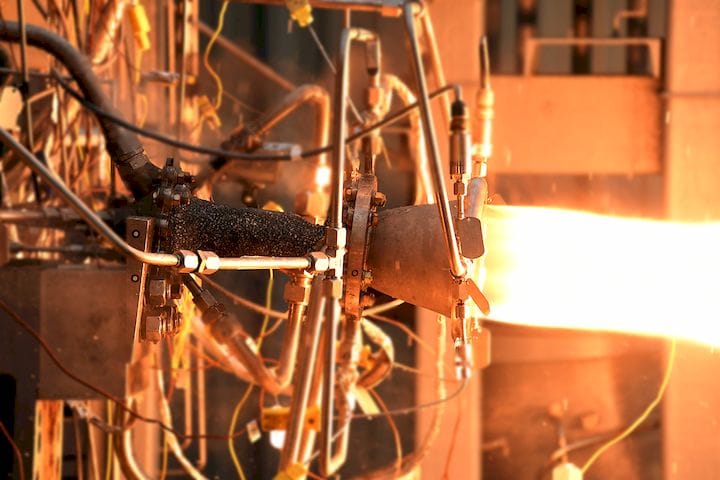![Testing a 3D printed rocket thruster with composite overwrap [Source: NASA]](https://fabbaloo.com/wp-content/uploads/2020/05/image-asset_img_5eb09988d8ec0.jpg)
NASA has successfully tested an unusual rocket thruster made with 3D printing and a composite overwrap.
NASA has long been experimenting with 3D printed rocket engines, and might even be said to have been the one that showed the way forward in 3D printed manufacturing. Their early experiments with metal 3D printing demonstrated it was possible to dramatically reduce the number of parts in an aerospace component when designing specifically for 3D printing.
It seems they are continuing in their exploration of not only outer space — but also inner space by means of their manufacturing experiments. One program they current run is called “Rapid Analysis and Manufacturing Propulsion Technology”, or “RAMPT”. This project’s goal is:
“The Rapid Analysis and Manufacturing Propulsion Technology (RAMPT) project will mature novel design and manufacturing technologies to increase scale, significantly reduce cost, and improve performance for regeneratively cooled thrust-chamber assemblies, specifically the combustion chamber and nozzle for government and industry programs. This addresses the longest lead, highest cost, and heaviest component in the engine system.
RAMPT’s purpose is to evolve an integrated multi-alloy lightweight thrust chamber assembly that significantly increases scale of current additive manufacturing technologies, reduce associated cost and schedule, and provide design options not previously possible. This project is planning to take advantage of government and industry investments through public-private partnerships and provide process development data and technology improvements across the propulsion and related industries.”
![The RAMPT 3D printed composite thruster concept [Source: NASA]](https://fabbaloo.com/wp-content/uploads/2020/05/rampt_wlabels-for-factsheet_result_img_5eb0998929847.jpg)
It’s not just words, either, as this project is quite real: they just tested a thruster developed with this manufacturing technology. The thruster includes a 3D printed combustion chamber, an additively made nozzle and a composite overwrap.
The test involved firing a 2400lbf thruster no fewer than 18 times in an effort to see if the new design could withstand the tremendous mechanical and thermal forces.
It did.
![Freeform blown powder additively making a rocket nozzle [Source; NASA]](https://fabbaloo.com/wp-content/uploads/2020/05/image-asset_img_5eb0998989f07.jpg)
What interests me most about this experiment is that they combined multiple types of manufacturing processes within a single component. They even used two different types of 3D printing processes to create the combustion chamber and nozzle. They explain how these were made:
“Freeform blown powder nozzle: The first key technology being matured under RAMPT is the freeform blown powder deposition additive manufacturing of the large scale regen-cooled nozzle structure. The goal of this process development is to advance the blown powder deposition for large-scale thin-walled structures to net shape or near-net shape to significantly reduce the time required for nozzle fabrication.
Composite overwrap structural jacket: The second key technology being developed under RAMPT is the composite overwrap of the thrust chamber assembly. This includes the GRCop-84/42 copper-alloy based material of the combustion chamber and the superalloy freeform nozzle. This technology offers the potential to substantially decrease weight up to 70 percent over metallic jacket structural supports.
Bimetallic radial deposition for manifolds: The third key technology area is the development of the bimetallic deposition for manifold land and/or integrated manifold to the GRCop-84/42 combustion chamber.”
While any specific manufacturing technology is powerful, I’ve often found that more can be achieved when combining making methods together. Each technology has its advantages and disadvantages, and in an item as complex as a rocket engine, it’s best to use the right tool for the job in each of the subcomponents.
Via NASA











Healthcare 3D printing attempts to solve two problems that plague providing care: customization and cost.